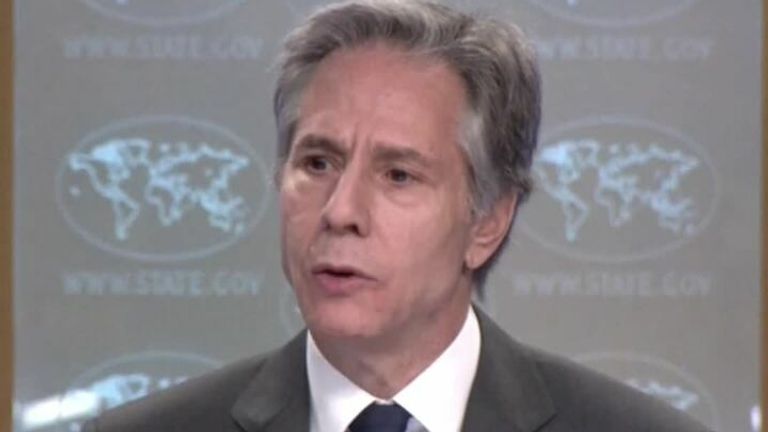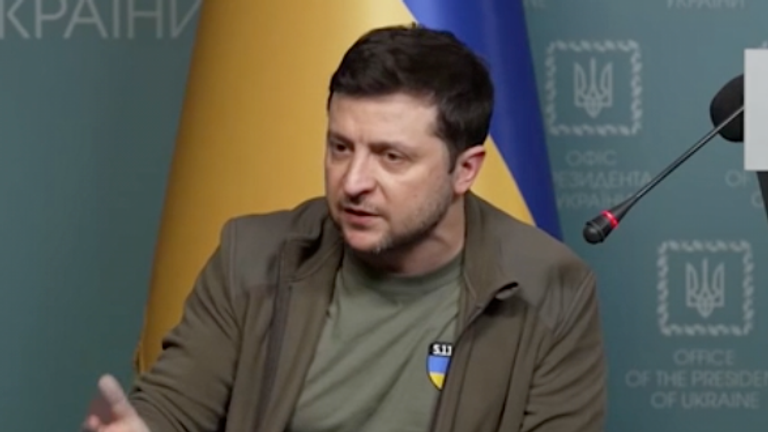- After the dissolution of the Soviet Union in 1991, Ukraine inherited the world’s third-largest nuclear arsenal. Three years later, Ukraine joined the Nuclear Non-Proliferation Treaty (NPT) as a non-nuclear weapon state and, by 1996, had transferred all nuclear warheads on its territory to Russia.
'Mistake' to give up nuclear weapons
Asked if Ukraine made a mistake in agreeing to give up its nuclear weapons, Svitlana Zalishchuk, a foreign policy adviser to the Ukrainian deputy prime minister for European integration, told Sky News: "Yes, without a doubt. . ."If we were the owner of nuclear weapons at the moment, I think that this war wouldn't have started, this tragedy wouldn't have been experienced by my nation."
She said world powers that own nuclear weapons are "untouchable" and "are not challenged with military force because nuclear war is a danger for the whole world".
"Because voluntarily we gave up on our nuclear weapons and the Budapest Memorandum has been ignored we find ourselves in the situation that we are in," she said.
"If there is one country in this world, in Europe today, that can demand security guarantees it would be Ukraine, exactly because we gave up our nuclear weapons, exactly because we received this assurance from the strongest powers in the world that they will protect us if anything happens," she continued.
'There was no guarantee'
Beyza Unal, deputy director of the international security programme at think tank Chatham House, said she understands why Ukrainians might feel "betrayed" but said the memorandum gave their country "assurances" - not a "guarantee" - which are not legally binding and have no enforcement mechanism.
- She also pointed out the nuclear weapons Ukraine had inherited could not have been used without investing in additional infrastructure.
"It was Soviet inventory," she said. "You can't actually use those weapons without having any command and control structure that is linked to the weapon system.
"It was almost impossible for Ukraine back in the day to use that even as a bargaining chip for the future."
After the isolution of the Soviet Union in 1991, Ukraine inherited the world’s third-largest nuclear arsenal. Three years later, Ukraine joined the Nuclear Non-Proliferation Treaty (NPT) as a non-nuclear weapon state and, by 1996, had transferred all nuclear warheads on its territory to Russia. What convinced Ukraine to relinquish its claim to a sizeable arsenal of Soviet nuclear weapons? And what lessons can we learn from Ukraine’s unique experience?
During an NTI seminar on May 18, Dr. Mariana Budjeryn, Senior Research Associate at the Harvard Kennedy School’s Belfer Center’s Project on Managing the Atom, shared key insights from her new book, Inheriting the Bomb: The Collapse of the Soviet Union and the Nuclear Disarmament of Ukraine. Her findings offer a nuanced perspective on Ukraine’s decision-making following the unprecedented dissolution of a large nuclear-armed state, shedding light on the complex interplay of domestic politics, economic considerations, diplomatic pressures, and the significant role of the Nuclear Non-Proliferation Treaty (NPT). Ukraine’s path to disarmament was anything but linear, however. Intense negotiations and diplomatic craftsmanship ultimately averted a looming nonproliferation crisis.
Ever since Russia began its brutal invasion of Ukraine in February 2022, public and political discourse about the role of nuclear weapons—and the impact of Ukraine’s decision to give up nuclear weapons three decades prior—has been divided. While some argue that Vladimir Putin would never have dared to invade the country if Ukraine had held on to its nuclear arsenal, others emphasize that the weapons located on Ukraine’s territory were never Ukraine’s to give up in the first place.
In recounting the country’s distinct nuclear history, Budjeryn noted that the truth – as is often the case – resides in the middle. Following the collapse of the Soviet Union, Ukraine inherited the largest share of the Soviet deterrent held by a Soviet successor state, with a majority of all strategic nuclear warheads deployed on Ukrainian-built missiles within its borders. However, the government in Kyiv had neither operational control of the weapons nor a nuclear fuel cycle necessary to sustain a fully independent nuclear weapons program. What Ukraine gave up was therefore not a full-fledged nuclear deterrent but, at most, a nuclear option.
That said, Budjeryn emphasized that, contrary to popular belief, Ukraine had options and agency. Despite claiming to be the rightful owner of the nuclear weapons on its territory as a successor state of the USSR, Ukraine made the conscious decision to disarm. While it had the technical, industrial, and manufacturing capabilities to act on its nuclear option, developing an indigenous nuclear weapons program would have required significant investment of already scarce resources amidst a grueling economic crisis. In addition, nuclear deliberations occurred at a time of prevailing anti-nuclear sentiment caused by the trauma of the worst nuclear accident in history: the 1986 Chernobyl meltdown. Nuclear weapons and technology were simply not popular.
Ukraine also faced political pressures from both the United States and Russia, which aimed to ensure that Russia emerged as the sole nuclear-weapon state following the collapse of the USSR. Budjeryn explained that Ukraine entered a world in which a certain order already existed. She observed that the nuclear share of Ukraine’s Soviet inheritance immediately fell under the unique rules and norms of the nuclear nonproliferation regime. Ukraine’s options at the time were thus guided by the NPT, which differentiated between nuclear-weapon states (NWS) and non-nuclear weapon states (NNWS) and recognized nuclear possession for only five states. Ukraine, however, was subsequently “born nuclear,” not fitting neatly into the category of an NPT-recognized NWS, an illicit proliferator or a NNWS. Its “claim to ownership” and “temporary nuclear status” would have defied the fundamental aim of the NPT to prevent the emergence of new nuclear states and earned Ukraine “outlaw” status.
Ukraine’s decision-making was further guided by the often-overlooked role of arms control. Innovative ideas such as the Presidential Nuclear Initiatives implemented by Presidents Bush and Gorbachev led to the withdrawal of tactical nuclear weapons from Ukraine’s territory, albeit with very limited Ukrainian control over the process. The Strategic Arms Reduction Treaty (START) to which Ukraine eventually became a successor-state party provided transparency and a legal imperative for eliminating the strategic offensive arms on its territory. When Ukraine started to seriously consider the option of retaining some type of deterrent against Russia, even if only conventional, it was the Intermediate-Range Nuclear Forces (INF) Treaty that constrained Ukraine’s options by banning missiles in the ranges of most use for Ukraine’s security environment.
Budjeryn’s presentation highlighted that nuclear decisions are multicausal. Ukraine’s unique path was shaped by a confluence of factors, including its national identity, quest for true independence, historical experience, economic considerations, and a desire to be recognized and welcomed as a new equal member of the international community. While Ukraine remained steadfast in its commitment to disarmament as enshrined in its Declaration of Sovereignty, it demanded to have a voice in determining when and how disarmament should take place.
The release of U.S. funds for the safe and secure dismantlement of nuclear weapons under the Cooperative Threat Reduction Act (also known as the Nunn-Lugar Act) formed part of a bundle of agreements that accompanied Ukraine’s negotiated disarmament. So did the pledge of additional U.S. economic aid and security assurances from the United States, the United Kingdom, and Russia, which were agreed upon in the so-called “Budapest Memorandum.” As Budjeryn writes in her book: “Ukraine regarded these weapons not as an active military force but, above all, as an asset that could, at least partially, compensate for its losses.”
The full extent to which Russia’s atrocious invasion of Ukraine will impact the global nuclear order remains to be seen. At a minimum, the invasion of a non-nuclear weapon state by a major nuclear power is deeply destabilizing, potentially fueling demand by vulnerable countries for nuclear weapons and dealing a serious blow to the concept of negative security assurances.
Importantly, Budjeryn’s book examines the counterfactual scenario, including the potential negative consequences on Ukraine’s international, economic, and security status if it had chosen to keep nuclear weapons. To those who have dedicated their careers to reducing the role and number of nuclear weapons globally, Budjeryn’s work offers valuable lessons for our understanding of nuclear nonproliferation and disarmament today and stands as a reminder that nuclear weapons are not the answer to perceived or real security vulnerabilities. In fact, Budjeryn concluded, the story she envisions us sharing is one where we can reaffirm that “it’s better to have friends than s.”







No comments:
Post a Comment